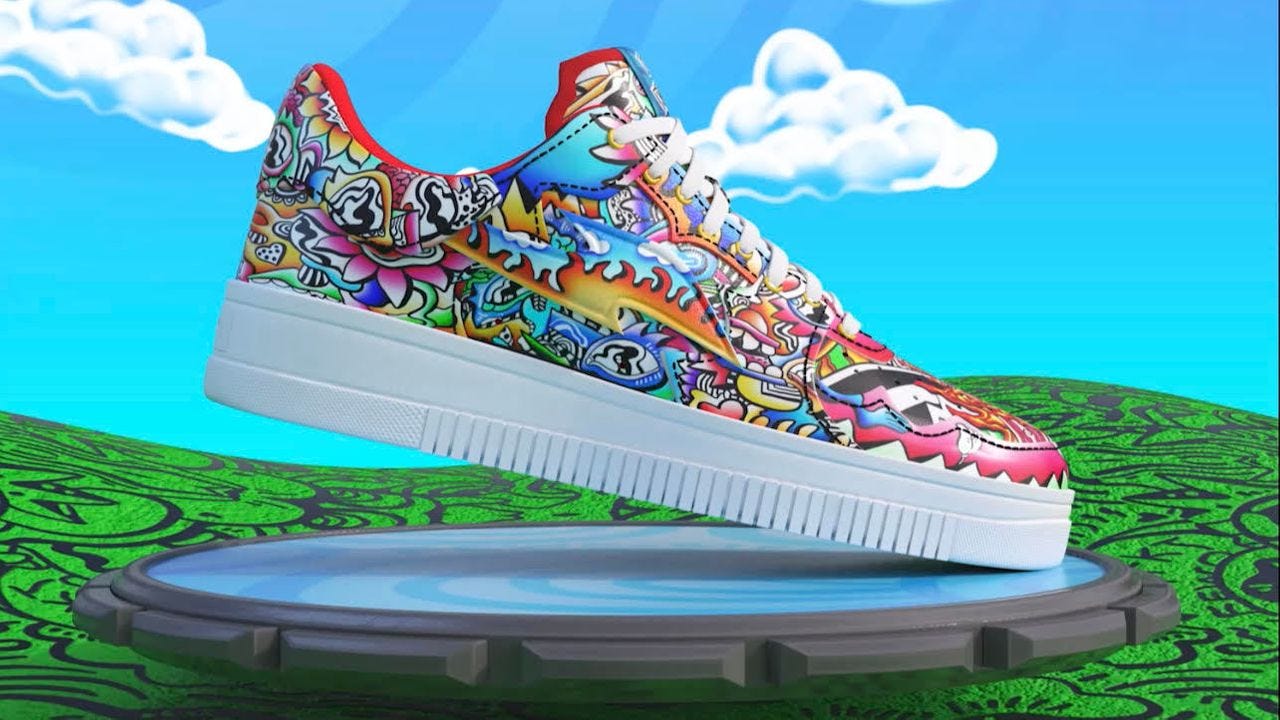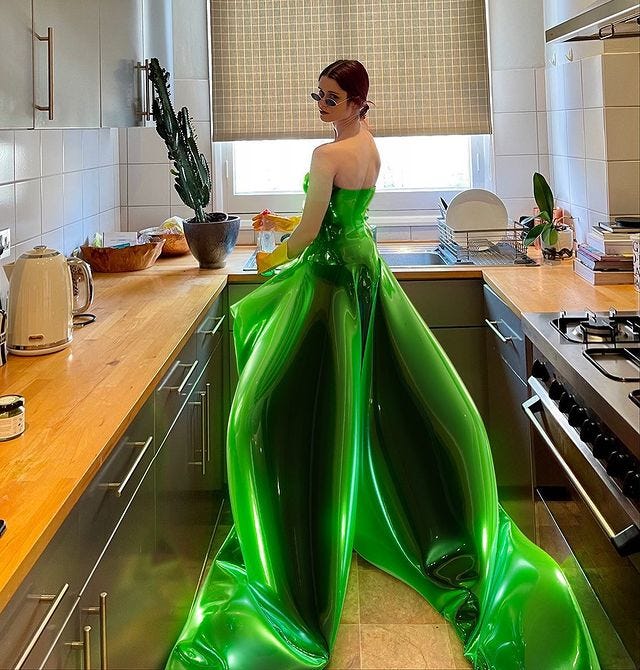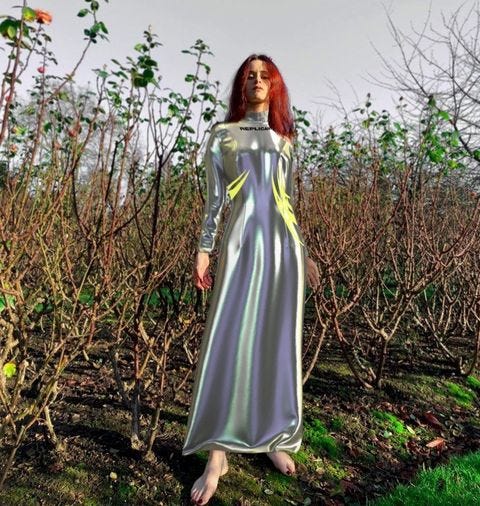Hello and welcome to the third edition of This Outfit Does Not Exist!
This month: changing consumption - what it means to buy, and own, something that doesn’t exist; fashion NFTs, past and present; Digital Fashion makes mainstream media, and how you can get involved.
The Long Read
Three months ago a sale of these ^^ Digital Sneakers raised $3.1 million in under 7 minutes.
Along with repetitive strain industry, the 600 lucky buyers received two things:
1) A pair of Digital Sneakers from 18-year old digital artist FEWOCiOUS in collaboration with RTFKT Studios
2) A physical pair of the same sneakers sent to their home
Fashion goods on the blockchain have been around for some time now. Arianee, Aura, VeChain and LUKSO all provide luxury brands with on-chain identities linked to physical products through QR codes or RFID tags.
Digital Sneakers aren’t a novel concept either. Fashion game AGLET, founded by Adidas former Head of Innovation, has been in the market since 2019; providing sneakerheads with their own covetable Pokemon Go alternative.
So if Digital Sneakers are old news (and by old I mean 2 years ago Grandpa!!!) what made the FEWOCiOUS drop so significant?
The answer is balance - the one between the value of physical goods and their digital counterparts. The FEWOCiOUS drop marked the first time in history that Digital Fashion was of higher value to consumers than its physical alternative.
NFT? WTF?
An NFT or ‘non fungible token’ is a digital asset stored on the blockchain which provides its owner with an immutable record of ownership.
NFT’s are valuable for three reasons:
1) They provide indisputable proof of who created a digital asset - the moment an asset is ‘minted’ (created on the blockchain) it is permanently sealed, attaching an immutable record of provenance.
2) They provide indisputable proof of who owns a digital asset - every time an NFT based digital asset changes hands it is logged unalterably on the blockchain.
3) They provide creators with the ability to generate revenue from resale - when minting an asset sellers can program in a percentage of the resale price to be automatically deposited into their accounts every time the item changes hands.
However there are caveats…
1) You can still copy an on-chain digital asset (you’re just more likely to get caught out!)- Just because you can show who created a digital asset on the blockchain, that doesn’t mean that someone else can’t replicate your creation and mint it as their own. That being said, as you can show an immutable record of provenance it is far easier to settle disputes around IP.
2) Owning an NFT doesn’t necessarily mean owning an NFT… if you get what I mean - Saying you ‘own’ a digital asset does not mean you own the source code, or even have exclusive rights to view and download the PNG file of the asset you’ve consumed. Frequently the digital asset itself resides on a separate blockchain entirely. In ‘owning’ an NFT, you typically just own the metadata associated with the asset - essentially an indisputable digital receipt with ‘directions’ (in source code) to where the original asset was created. Whilst this is fine for some, it’s an understandable deterrent for others.
3) The NFT market is a bubble and a big one - NonFungible.com, which tracks the NFT ecosystem, noted that market highs for NFTs surged 2,100% to $2 billion in sales during the first quarter of this year, then plummeted. NFT prices are now down 70% from their peak in mid-February, going from an average price of $4,000 to less than $1,500 in early April. That’s not to say that NFTs won’t have continuity, or provide immense future value, but that rotating graphic of the Dogecoin Shiba Inu you bought on OpenSea for $6,000. Well it will probably worthless before the year is out.
So what’s the deal with these Digital Sneakers?
Going back to those who risked their hard-drives and wallets, alongside the motion in their digits, participating in the $3.1 million FEWOCiOUS drop; driven by the belief that these shoes had value. Well to their credit they were right.
If you were a consumer in the original FEWOCiOUS X RTFKT auction you’d have bought your Digital Sneakers for 1.8 ETH ($5,000).
If you were now re-selling those shoes on OpenSea (a secondary NFT marketplace) you’d be fending off offers of around 5.5 ETH ($15,000). That’s 3X on your investment in one month. Not bad.
What’s more, due to the programmable secondary seller fees mentioned above, you could have 5% of the resale price deposited directly into your bank account, every time the shoe changes hands. Assuming they triple in value every three months, and get sold at the end of each three month period, by year end you’d have made $29,250 off resale alone.
Now that’s one lucrative pair of sneakers.
If a shoe sells for $3.1 million and no one wears it, can you call it a shoe?
It’s pretty clear from the dynamics explored above that the majority of FEWOCiOUS buyers weren’t buying a shoe. They were making an investment.
The Digital Sneakers may as well have been a piece of $69 million NFT art by Beeple, or a $2.9 million NFT Tweet by Jack Dorsey. So the question is… are these Digital Sneakers really Digital Fashion?
It would be untrue to say that fashion items are never consumed as assets. Buyers of Haute Couture gowns, or Birkin Bags have been known to resell them at huge premiums. Nonetheless, in order to truly be called ‘Fashion’, I’d argue that an object must be made to be worn. As Digital Assets are programmable - meaning the maker clearly defines what they can and can’t do at time of creation - the FEWOCiOUS drop was not Digital Fashion as it will never be wearable. So by those standards… what is?
Owning a garment that doesn’t exist
Over the past month, an amazing array of ways to ‘own’ Digital Fashion have cropped up. These range from direct-to-avatar NFTs, to instant virtual try-ons. Not only does delving into these modes of ownership help clarify what distinguishes Digital Fashion from Digital Art, but it also sheds light what on what what digital-bang a Virtual Fashion consumer is getting for their physical-buck.
So I sat down at my computer, my favourite physical fashion item by my side (an Alexander McQueen dress from Depop), and broke down what owning a fashion item means into two distinct categories:
1. Functionality as a garment:
I can wear it when I like
I can wear it how I like
I can wear it where I like
I can make adjustments to it
2. Functionality as an asset:
I can sell it
I can trade it
I can give it away
I can dispose of it
I then went on to apply these 2 categories, and their 8 criteria, to the various methods of Digital Fashion ownership I’ve experienced since entering the space. With the following results:
1. Digital Tailoring - Photographic Render
What it is: The prevalent way of a human wearing Digital Fashion. In this process, after adding a Digital Fashion item to Cart, the buyer selects an accompanying photo - the one they wish to wear the digital garment in. On receipt of payment, the brand acts as a ‘Digital Tailor’ – using a specially designed game engine to put the buyer in the clothes, and sending it over in 24-72 hours.
Garment Functionality: Although the results are pretty spectacular, to rate against the 4 characteristics of Garment Functionality this method ranks pretty low. You can normally only wear the Digital Fashion garment in a single photo, and it takes between 24 and 72 hours to get your photo back. You can also only wear the designs provided on the website with 0 room for modification.
Giving the method the benefit of the doubt, because, to its credit, it can create the most amazing photos, I’ll assume most users are wearing the garments how they like (0.5) and where they like (0.5) – as they select the photo.
GARMENT FUNCTIONALITY: 1
Asset Functionality: Unfortunately all elements of Asset Functionality listed above are lacking. You get a photo of yourself in the outfit but no rights to the outfit or the photo. That’s not to say you can’t indirectly monetise it, but to be strict, there’s no way to benefit off the direct transfer of asset ownership from one buyer to another.
ASSET FUNCTIONALITY: 0
OWNERSHIP TOTAL: 1/8
2. Telegram Bot - Instant Try-on
What it is: Replicant founder Regina Turbina partnered with Telco to create a Telegram Bot which dresses users in one of 7 Digital Fashion looks in under-60 seconds.
Garment Functionality: The Telegram Bot’s ability to ingest and instantly dress multiple photos of a user, means you could wear Digital Fashion wherever you like, and whenever you like. However, it loses out as the software is only available on photos (no in-game portability), doesn’t work on video looks, and is limited to seven pre-set Digital Fashion designs.
GARMENT FUNCTIONALITY: 2
Asset Functionality: As with the photographic render method, direct Asset Functionality is lacking. On the bright side, due to the Bot’s ease of use, the more entrepreneurial digital fashionistas among you can get friends to pay you to dress them through the Bot!! (the looks the Bot provides usually cost around $15 on the replicant website)
ASSET FUNCTIONALITY: 0
OWNERSHIP TOTAL: 2/8
3. The AR Filter – Ease of Access
What it is: Everyone from Gucci to Tribute is experimenting with Digital Fashion based Augmented Reality. Body tracking is hard (even foot tracking is glitchy!) - hence why photographic renders prevail. However, based on its possibilities, AR is a strong competitor for the medium of choice in Digital Fashion’s future.
Garment Functionality: With AR, try-on is immediate, so you can wear garments when and where you like! Gucci trialled this new model with its AR trainers through app WANNA. For a mere $12 consumers could unlock a pair of digital Gucci sneakers to wear on demand. What’s more, when it comes to the modification element AGLET is already working on an in-game sneaker design studio so players can enhance their discoveries.
Having said all this I’ll deduct 0.5 points because I haven’t seen proper AR-in-game portability as of yet.
GARMENT FUNCTIONALITY: 3.5
Asset Functionality: Unfortunately again another 0 as you can’t currently transfer/ directly monetise ownership of AR assets.
ASSET FUNCTIONALITY: 0
OWNERSHIP TOTAL: 3.5/8
4. The collectible NFT
What it is: Collectible NFTs are assets, minted on blockchain, which take the form of fashion items (FEWOCiOUS X RTFKT I’m looking at you!!!)
Fashion is separated from art by function (art is experienced by the consumer; through exhibition, whilst fashion is experienced on the consumer) so I’d say these assets are more akin to the work of Fashion Photographers that Designers. Nevertheless, after looking at works like the The Fabricant X Adidas Making Strides I had to include it in the matrix.
Garment Functionality: Put simply you can’t wear it.
GARMENT FUNCTIONALITY: 0
Asset Functionality: As these are fully functional NFTs you can sell, trade, gift or bin them. Once you own them it’s up to you.
ASSET FUNCTIONALITY: 4
OWNERSHIP TOTAL: 4/8
5. The interoperable NFT - form & function
What it is: A cohort of creators have realised that fashion is made to be worn, and created Digital Fashion NFTs with Garment Functionality. Hurrah!
Garment Functionality: It depends which platform you’re buying on, but Digital Fashion start-up The Dematerialised have already programmed their Digital Fashion assets to be worn by both humans and their in-game-avatars. So wear whenever you want and wherever you want scores maxed out for that!
In terms of the how and the question of modification Digital Fashion NFT provider Digitalax has you covered. Operating on a Fractional Ownership System their garments are split out into layers each represented by their own NFT. The ‘Parent’ layer takes the form of the entire garment, such as the METAJACKET above ^^, whilst the ‘Child’ is the composite patterns, prints and fabrics the Parent is made up of.
Although at the moment Digitalax don’t offer consumers the opportunity to play with these layers, I believe that with time they will come to mirror platforms like async.art and offer consumers the opportunity to mix-and-match layers to distort garments as they choose… so an extra 0.5 for that.
GARMENT FUNCTIONALITY: 3.5
Asset Functionality: Just as the collectible NFT’s above you can sell, trade, gift or bin these items. Though as these currently have a tendency to triple in price (see the 3X FEWOCiOUS shoe), I’d think hard before doing the latter…
ASSET FUNCTIONALITY: 4
OWNERSHIP TOTAL: 7.5/8
6. Source File Ownership
For some time Digital Fashion house The Fabricant have made their design source files fully accessible to encourage collaboration.
The potential of this is incredible, allowing full functionality against my present matrix in both utility as garments, and as assets.
The issue is, that without mastery of Digital Design Tools, providing source files is equivalent to providing a physical non-designer with a roll of silk and congratulating them on the owning that new Dior dress they’ve been lusting over. (a nudge to us all to get onto CLO3D!)
However as Digital Design becomes increasingly accessible (I’m thinking parallels to the low-code wave) – and creators in the space can monetise designs alongside finished products, this method of creative consumption is important to note.
OWNERSHIP TOTAL: UNRANKABLE
Thanks for this framework but it still doesn’t explain why people are spending money on clothes that don’t exist …
(…especially if you can’t guarantee they’ll triple in value)
As we have already produced enough clothes to last us the next 50+ years, there are already items that keep us warm, keep us cool, and show our bosses we mean business on the morning Zoom (even if everything out of shot is loungewear). Therefore fashion’s contribution to the consumer is more than functionally objective. When consuming an item an individual approaches it with a unique take on how they want to use it and what they hope it provides.
People buy Digital Fashion to be creative, to flex, and as stated above, for investment purposes. But let’s dive into the psychology of one sort of Digital Fashion consumer, the Content Creator - who buys Digital Fashion to be worn in photos.
The Content Creator wants to use the Digital Fashion item to create a photo which will garner eyeballs - the type which come with likes, shares and swoons. We can assume they also hope these eyeballs translate into revenue - through followers, partnership opportunities etc.
Although I gave the Photographic Render a score of 1 on my earlier Ownership Matrix this is completely subverted when it comes to someone using Digital Fashion for the purposes stated above.
To get their desired outcome, a Content Creator doesn’t need to wear a digital dress in multiple photos; they couldn’t care less whether it ports to Fortnite; have no interest in changing its shape; and if it takes 24 hours to create the image, so what? (assuming they’ve planned their grids far in advance…)
Equally to a Content Creator it’s of little relevance if a digital dress can be sold or traded because they derive financial value indirectly through the photo it’s worn in. The likes, shares, buys (of the magazine featuring them) and accompanying partnership offers, are what’s important here, and more than justify the $69 (virtual) price tag.
Ultimately, despite scoring low on my Ownership Matrix a Digitally Tailored garment still has full functionality to the content creating buyer; both as a garment, and an asset. Equally, just like the NFT shoes that went for $3.1 mil, it possesses perceived value due to its scarcity. A Tribute dress, similar to the NFT sneakers, has limited supply; only 100 of each design are sold. For Content Creators this means their image is assuredly unique, driving up the value of the asset used to create it and making it more desirable.
Catering to the new consumer
The exploration of value above, shows that Digital Fashion needs different abilities to appeal to different consumers. While current content creators require few elements of Garment Functionality outlined in my Ownership Matrix for their digital clothes to provide value, I’d argue that the burgeoning generation of Digital Fashion consumers do.
As Digital Fashion spends in games spanning Fortnite, Animal Crossing, Decentraland, Roblox and CryptoVoxels suggest, dressing your avatar is increasingly important to players. There are a smorgasbord of reasons one would spend on in-game Digital Fashion assets, but ultimately, as with physical fashion, it comes down to the desire to show yourself and control how others perceive you.
Something which is far easier when you can take (almost) any form!!!
As we move increasingly towards a Direct-to-Avatar economy (one where people consume goods for their in-game characters), creators should stop to consider when, how, and where their garments can be used, as well as whether they can be modified; maximising the ways their consumers can bridge the gaps between who they are and who they wish to be.
Digital Fashion is exciting because it can do more than its physical counterparts in empowering chosen identities to manifest. Aside from if you’re an Everest mountaineer, or own a Jetpack, most of the superpowers you get from what you wear in the physical world are psychological (that person views you differently because you look like this etc.) With Digital Fashion for in-game worlds these superpowers are far vaster and can be explicitly functional; A gown that makes you look like Cat Woman could allow you to become more agile in whichever virtual world you elect to wear it. It could also give you the power to unlock collector communities or give you DAO voting rights over wider platforms. All exciting prospects!!
A final note to creators
Although the FEWOCiOUS drop was undoubtedly led by some profit hungry NFT bulls trying to make some $ (rather than ETH or BTC) the balance between conceptions of physical and digital value are unquestionably shifting.
As explored above, Digital Fashion can allow consumers to show themselves in entirely new ways, with far reaching implications. As we move to a new hybrid-phygital generation where Digital Fashion goods are abundant, Designers can distinguish themselves by approaching creation consciously, through a consumer centric lens.
For those trying to create a digital asset, like the FEWOCiOUS shoe, go ahead and think of what will beckon the circle of crypto-vultures; allowing you to capitalise quickly before the NFT supernova implodes.
But for those trying to create Digital Fashion items to be coveted long-term, consider how you can provide maximum value to your consumer. How will they use your good once they own it? And how can it transform them into their best selves on-screen?
… Do the above correctly, create an asset to express and empower, and you’ll be coded into Digital Fashion history indelibly
(after all the metadata’s stored on chain…)
This Month in Imaginary Clothing…
Digital Fashion featured in Vanity Fair, Business of Fashion, Dezeen, WWD, GQ, Jing Daily and more…
The Dematerialised co-hosted an exhibition on The History of Digital Fashion with Meta_VS CryptoVoxels
The RTFKT X Fabricant X Dematerialised RenaiXance drop sold out in under 11 minutes
Gary James McQueen held a fashion show for 100% Digital clothes to be consumed instantly in collaboration with DressX
Ecosystem Exploration
Nine-Notable Nifty’s
Kevin McCoy’s Quantum (about to be auctioned at Sotheby’s) goes on-chain as the first NFT ever minted - 5th of March 2014
Dragon the world’s most expensive Cryptokitty who currently trades at 600 ETH ($2,308,000+) was born - 28th of August 2018
The Fabricant Iridescence Dress - a collaboration between the Digital Fashion House and Dapper Labs is sold for $9,500 - May 2019
RTFKT X Evolutions Digital Sneakers sell for $22,500 (22ETH) to notorious collector WhaleShark - December 21st 2020
The METAJACKET - a collaboration between Digitalax and RTFKT auctions 4 metajackets raising $125,825.05 (47.999 ETH) in 7 days - February 2021
The Dematerialised HexJerzo Digital Asset - the first fully-portable, phygitally-wearable Digital Fashion asset sells out all 1212 copies - February 2021
The Fabricant X Karlie Kloss #makingstrides Competition - digital designers compete redesigning the adidas wind.rdy parka, with the leading submissions minted as NFTs through Rarible - March 2021
The FEWOCiOUS X RTFKT Digital Sneakers - RTFKT sell 600 pairs of Digital Sneakers raising $3.1 million in 7 minutes - March 2021
The Fabricant X RTFKT X Dematerialised RenaiXance - the first ever fully-portable, phygitally wearable, Digital Fashion drop sells out in under 11 minutes - April 2021
This Outfit Does Not Exist, is a platform bringing Digital Fashion to life through exploration, explanation and exhibition. The newsletter will dive into the industry’s developments, the start-ups that shape them, and their capacity to disrupt the wider world of physical goods.
Each month will explore a theme: from digital design & distribution, to marketing in the Metaverse. I’ll also showcase the most brilliant feats of digital design via Instagram.
Love it? Hate it? Don’t understand it!
And share with your friends!!!
— Dani, This Outfit Does Not Exist










